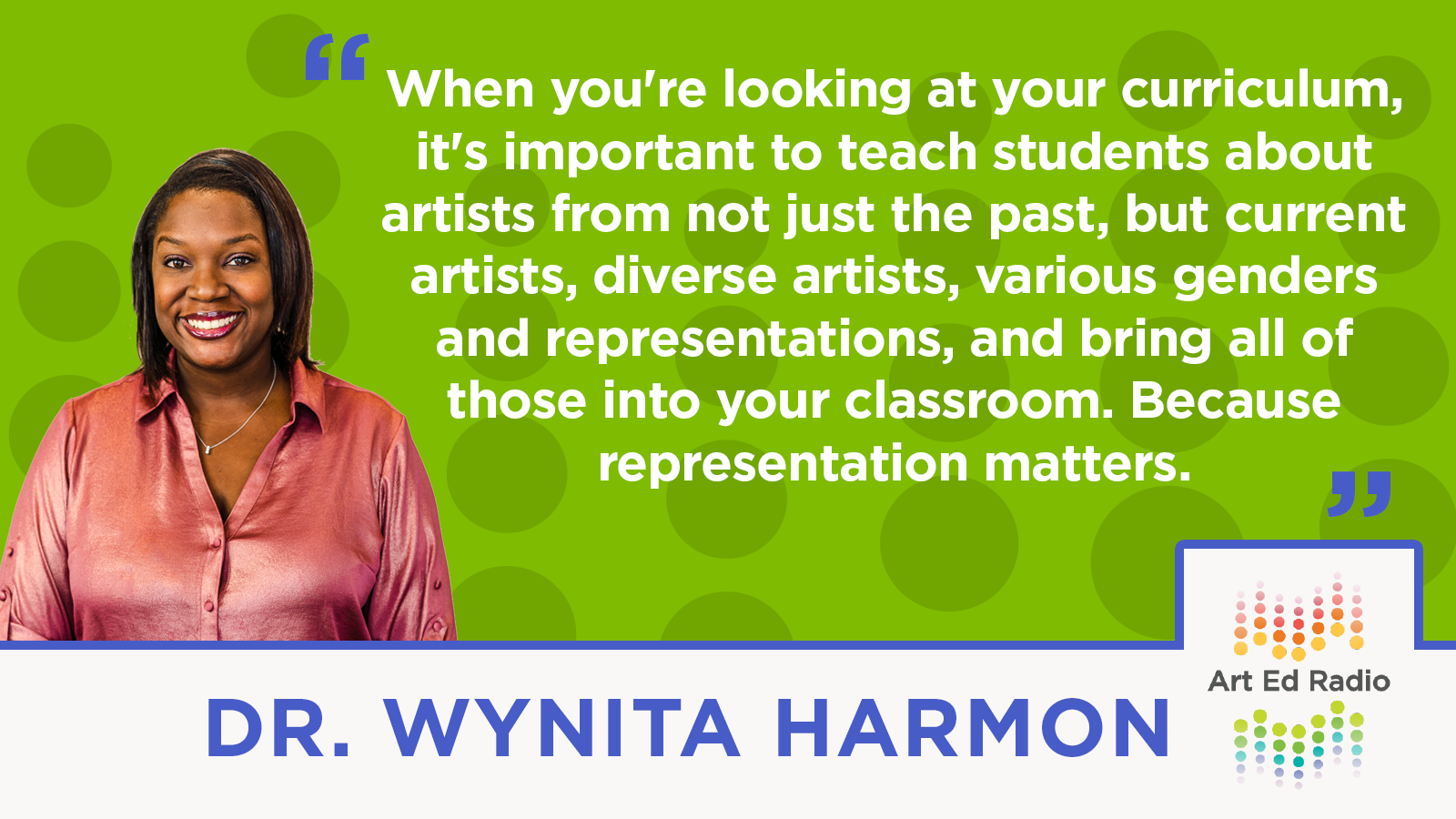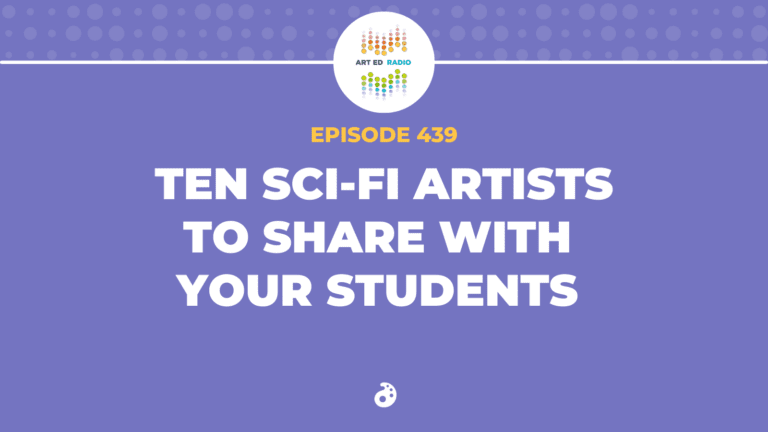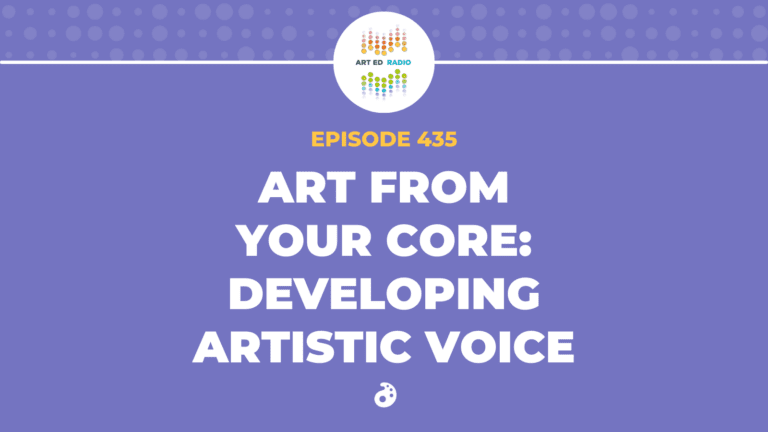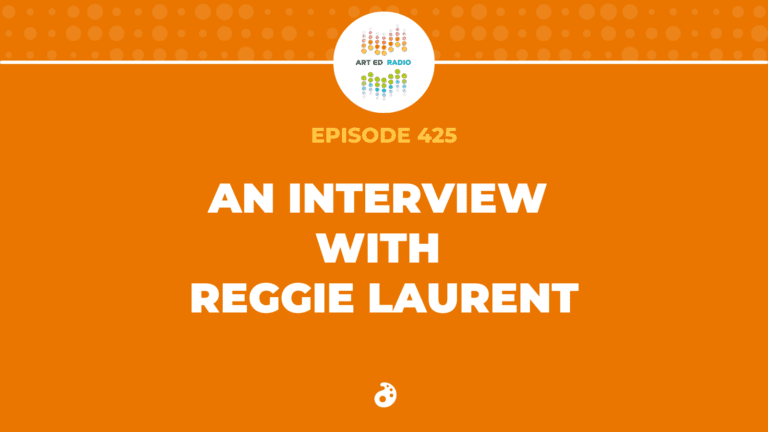What does it look like to have difficult conversations in our art rooms? How do we work with our students as they take on the topic of race in their artwork? Today’s episode is the second part of a conversation about how we address race in the art room with guests Lena Rodriguez, Jenn Russell, and Dr. Wynita Harmon. Full Episode Transcript Below.
Resources and Links
- Listen to Part 1 of the Conversation
- Download: 17 Black Artists to Know
- See Tim’s Twitter thread of living black artists
- The Perfect Project for Art and Activism
- How to Help Students Reflect, Process, and Enact Change

Transcript
Tim: Welcome to Art Ed Radio, the podcast for art teachers. This show is produced by the art of education university. And I’m your host, Tim Bogatz. This week, we are diving into part two of our conversation with Lena Rodriguez, Jen Russell, and Dr. Wynita Harmon. We talked last week about how we address race and how we address difficult topics in the art room. If you missed that episode, please go check it out. It should be in your podcast feed, and we will link to it in the show notes as well.
This week, we are going to continue talking about inclusivity, representation, and cultural appropriation. And just like last week, I’m going to do my best to stay out of the way and listen. We’re getting into it mid-conversation, but let’s go ahead and dive right in. Here is the second part of our discussion with Lena, Jen, and Wynita.
Wynita, I want to come back to you for our next question too, because I think you have some good ideas here. I want to ask, what are some things that we can do as teachers to create an art room or create an environment that’s more inclusive and more representative, like resources, curriculum, even specific lessons? What are some of the areas where teachers can take steps right now to make sure that they’re including everyone?
Wynita: Right. Well, I think first off, looking at yourself and just researching more about cultures, appropriation, implicit bias, and just checking yourself first, just getting that deeper understanding. Also, looking at your students, you need to know those relationships are really important. Getting to know them, asking questions, see what they do on the weekend. What did they eat for dinner? You’ll gain lots of information and context about your students from that, like they don’t always all have both parents at the home. Maybe their parents are working late.
So, just understanding that. And then, I was always mindful about when we came back from the holidays, what did you do this summer? Some students are just sitting around the house. They don’t have that money to go and travel and different things. So being aware of your curriculum also, with students.
When you’re looking at your curriculum, I also think that it’s important to teach students about artists from, not just the past, but current artists, diverse artists, various genders and representations, bringing that into your classroom. I’ve seen a few contemporary artists like Jerrell Gibbs and how he highlights important memories. So, that’s a way for students to bring in their own experiences with art, but also learn about different diverse artists. Kenturah Davis.
Do you teach about specific movements? I always brought up the Harlem Renaissance and it didn’t just have to be black history month, but it was definitely a big movement for African Americans to have the arts and the culture and we talk about it. With the way I brought in choice, students could create poetry. They could create art and different things like that. So, just giving them that platform.
Look at your classroom library, bring in books about diverse groups of artists, characters. Students want to see themselves in their school. If you don’t have maybe the staff that represents them all, at least bringing that curriculum that helps them connect even more. What else? Looking at your materials. I’m a big supporter of multicultural crayons and construction paper and paint and things like that. I would have, my students put a crayon next to their arm and they’re like, ‘What shade am I?”
Those are really important things I know growing up, I just had one choice, so it’s nice to have those different variances in your materials. When it comes to portraits and drawing your family, you want to be able to express them correctly. Let’s see, bringing in topics like identity, portraits, current issues in the world, I think are ways to bring in those diverse experiences that people have. Not necessarily bring it up directly for elementary, but it’s a way to have a soundboard for students to like, oh, this is what I’m going through. Or oh, hey, I think this is very important.
I always like to follow Melissa Purtee, and one of her themes that I really love is “Take a Stand”. So students will take a stand against some social issue, and I would do this usually with third, fourth, and fifth. They could create posters, they can choose their medium. So just giving them those choices in just that area to create and express themselves, overall, and think about diverse ways to enhance their knowledge.
Tim: Yeah. That is a lot of good advice. All right. So Jen, do you have anything that you want to add, like what you do to create an inclusive curriculum?
Jenn: Yeah, we do … There’s just a lot. I’m trying to organize my thought process here. But we talk a lot about hair in my class. When we break down a portrait … because I start portraiture in like drawing two, so with my sophomore babies … I’m pretty sure they’re going to hate me for calling them babies, but it’s totally fine.
We go through studies and so they do eye studies, then nose studies, then mouth studies. And then as they progress, I’m like, okay, so now we’re going to do hair. They’re like, “It’s just hair. Why?” I’m like, well, how do you draw curly hair? And then they do a spiral motion with their hand, and I’m like, uh-huh (affirmative), if that’s what your hand is doing, what do you think the pencil in your hand is going to do?
Because let me tell you, my hair’s curly and it doesn’t do that. So, it forces them to really think about it. On the list of things when they start doing their hair study, it’s like, how to draw braids, how to draw textured male hair or short hair, how to draw wavy hair, how to draw a ringlet curls and where is the highlight? I teach drawing predominantly, so I’m like, “What is a pencil stroke going to look like for it? What do you have to focus on?” And all of these things.
Because it’s not only my black kids that have curly hair, we just have so many cultures in our school. And then, on top of that, a lot of my boys get perms and that’s a thing that I haven’t seen in the last three years. I’m like, okay … and I’ll go sit at a table and I’m like, “Okay, your hair looks different today. Explain it to me. What did you do and how did you do it?” Because a perm to me is different than a perm to one of my kids. The perm to me is to straighten my hair, but a perm to them is curling it, and that’s a whole different cultural thing that I had to learn.
So, we do talk a lot about hair. And then we have my kids do an artist that you relate to. So they have to find an artist, and I allow it to be an artist. They just need to find one, because they’re like, “Well, can it be from Instagram or someone that I saw on tik tok?” I’m like, “You know what? Yes, because that’s someone that you’re identifying with that either looks like you are busy making art that calls to you.”
So, I said this before, but my classroom is the catch all and I house everybody. So I have trans kids, I have nonbinary kids, I have gay kids, I have straight kids. I have kids from all sorts of financial backgrounds, and I have kids that look all sorts of different ways. So, it’s cool to see who they pick, but that allows just the choice to relate to somebody, and they have to tell the class, like why do they relate, how that person relates to them, whether it’s because they look like me or they’re making art that looks like me, or it’s relating to me in, since they’re also gay and their art speaks to social issues that we just went through.
It’s really cool to see who they pick and why. It just all goes into a cloud database that they can access later, like a sketchbook library. So that’s one big thing that we definitely talk about. And then, my hair studies, which my kids aren’t a fan of, but then they can actually draw hair normally and it looks great and not little spiral ramen looking things.
Wynita: Can I jump back in on that real quick, Tim?
Tim: Yeah. Yeah.
Wynita: Okay. So with the hair thing, even in elementary, portraits and everything, I think a big thing that I had in my classroom was anchor charts. They focused on all styles of hair, not just Caucasian hair but like you said, the curly, how to do braids. So, I think students seeing that representation, even just in posters in your classroom, is a great way to let them see that they’re represented too.
Tim: Yeah. That’s a really good point. Lena, do you have anything you want to add to this or you want to talk a little bit about what representation looks like in your art room?
Lena: Yeah. We do a little bit of what these other awesome teachers are doing, just exposing the different artists and things like that and talking to them about different features and things like hair. But one of the things, we’re really fortunate to be able to live in an area where there are so many museums and galleries in different neighborhoods. So we’ve been able to take our kids out to look at Asian art and to look at black art and look at special exhibitions at the Latino cultural center and things like that.
So, they’re able to see and witness firsthand some of these works that are being done by contemporary artists. My suggestion, when you don’t live in one of these areas that’s not just jam packed with cultural outlets or maybe you are and you don’t have the budget, one of the things that I’ve been noticing a lot, especially with everything being shut down, because of quarantine, a lot of online museums are accessible, but not just that, that you can create your own experience and create something where it looks like an actual gallery, and there’s different walls, and different ways that you can venture out.
I could definitely see myself or seeing even the students create some of these virtual galleries of artworks that are reflective of different types of artists from different backgrounds, in different styles. So, I think just showing them what’s being created by people today … I’m with you, Jen, when they say, “Well, can it be an Instagram artist?” A lot of times, I like to look at it first just to make sure this isn’t somebody that’s just stealing somebody else’s idea or oh, boo, this is actually so-and-so’s work, and they just tweaked this or that.
And then I advise them to look up the original artists or whatever. But for the most part, there’s some really amazing artwork that’s being created, and social media has made it possible for people that didn’t have those connections and have the availability to be able to show their work, they have accessibility to it now. Really, social media artists, Instagram artists, have a bigger following than a lot of artists today that are being represented by top galleries, and it’s from a completely different demographic of people. Before, art was something that … it wasn’t a right, it was kind of like a privilege, and you had to be in certain circles or you have to have access to certain money, or you had to feel comfortable stepping inside a museum and not feel out of place.
So, shout out to all the Instagram artists that are making it possible for our students to be able to see what’s being done in real time and getting to be a part of that. So yeah, it’s just taking them to different places and having that … I love the idea of the anchor charts, just having that stuff visible for them, because some kids aren’t going to be as vocal and step up and ask those questions. But if they see those things or you’re guiding them through a gallery and they are connecting with them, sometimes they’ll never have that conversation with you, but they’ll remember those experiences and how they felt validated in who they are and what they look like, or feel comfortable with their neighbors and their classmates that are different from them, because now they have a deeper understanding.
Tim: Yeah. That’s an excellent point. Now, just to close things up, I want to talk about kind of the flip side of that and just what kinds of things we maybe need to avoid in our classrooms. So Jen, I’ll start with how do you think we can be a little more conscientious about issues of race? And how do you think we can avoid cultural appropriation in our teaching?
Jenn: Well, like I said, I always start the year just … I don’t want to say giving a warning, because warning is kind of a strong word, but just an asterisk label or something on my class, just letting them know that like, hey, you signed up for an art class, just a reminder, and it’s called drawing. If you didn’t know, we were going to draw a lot in here, because that’s a constant complaint that I get and I’m confused on.
But we’re also going to be looking at a lot of stuff. I always try to make it as silly sounding as possible when I say, I’m like, “You guys, we’re going to be looking at like nudie pants people.” And they’re like, “Why do you have to say it like that?” Because I have high schoolers. I’m like, “Well, because you act like that.”
So, we talk about that. We look at sculptures and all of these lines, and just mark-making, and we talk about cultures, and we look at different people, and we look at different art, and within the classroom, there’s 25, 30, 32 which is the cap, different people with different experiences, with different backgrounds.
I’m like, you’re going to have to open the mind a little bit if you’ve never experienced somebody else. But at the same time, that experience is going to be so valuable to you as you move forward, and as you go out into the world, and as you go to college, if you choose to go to college. Especially if it’s a school that you have in a place that you’ve never been to. A lot of my kids go out of state, and a lot of my kids go to art school, and when they go visit, they’re like, “Whoa.” I’m like, Uh-huh (affirmative). I told you. Remember? We talked about that.”
Just that preface, that just little … The first two to three weeks, we just talk about, remember, we’re going to look at this. Remember, we’re going to see this. Remember that art comes from a place of vulnerability. We are going to look at a lot of personal artwork. When we critique, there are people that are going to have a hard time explaining, but they’re going to tell you something very, very important about themselves. You need to listen, and you need to be open about it. It’s easier for some kids than others, but I always just start with that label on my class, just having them know and understand.
But I think the one thing that I do avoid is, when talking about cultures and race, is just a political opinion. I avoid political opinions period in my classroom, as far as me handing them out. The kids could talk about it all day if they want to. They don’t. Sometimes they do, but for the most part, they’re just like, “Okay, cool, dude. That’s your choice and that’s okay. Just make sure you research all the things and all the candidates or whatever.”
But as far as when talking about race and culture, I just turn off the political. But as far as talking about it, we just have an open policy, just an open mind. The platinum rule for us is just to be open and be aware and be polite. So, for the most part, my kids are really great about it. If they have questions, they will ask a person. That’s one of the things that I’m most proud of in my classroom is that they’re so willing to just go ask each other. “Okay, so you said the other day that you’re Korean. Okay, let me ask you this.” They broach it in that way and they have a conversation about it.
Or they come and ask me. This year, I decided to stop straightening my hair, which was a huge thing, and I told my kids that it was a new year’s resolution. They were like, “Okay, why?” I was like, “Let me tell you about it.” We had this whole conversation about it, because I was like, “Why is this not a big deal to y’all?” Validate me, please.
Your hair is cute when it’s curly, why is that a such a huge deal? And I was like, “Let me explain it to you.” That was in January. And then we had black history month and I did a panel on hair. They’re just like, “Okay, we see now why it’s a huge deal for you.” One of my girls was like, “Can I join you on that?” I was like, “Yes, girl, you can hop on the natural hair train.”
But those open conversations happen a lot in my classroom, but none of it has to do with … That’s one thing that I can’t preach to my kids about, or that I just don’t, that I won’t go into with my kids, is just my personal political opinion. So, that’s where I squash it. But we could talk about race and culture all day. But yeah, I just won’t go into candidates or anything.
Tim: Yeah, fair enough. All right, Wynita, can I get your thoughts? How do you talk about race and culture? How do you do that in a way that we can avoid cultural appropriation in our rooms?
Wynita: Well, my stance, pretty much, is it’s okay to be inspired by the cultures and all the beauty that they bring, but people should be aware of ways not to exploit it and just not copying it. It’s not a Halloween costume, different things like that. I feel like, with my students, I want for them to see the work, take in those techniques, take in the topic, see the personal feeling behind what artists are creating, and use that to create their own story. So, just having them view those things, not copy it, learn techniques from it, and then create their own work from it. That’s how we usually deal with that at my level.
Tim: That sounds really good. And then Lena, if we can just finish up with you. I know this is something that you’re passionate about, how we deal with culture in the art room, how we avoid appropriation. What else would you want to add there?
Lena: Because again, we’re capturing kids at our school, we start off the year with social contracts in each class. So basically, that entails a conversation, and it can take one or two days, one or two periods. What do you expect from your classmates throughout this year? What do you expect from me? How will we treat each other and what does that look like? So, everyone gets to add words to it, and sometimes social contracts will have a ton of words. Some of them it’ll have five or six that they feel like encompasses a lot of those other smaller things.
So, trustworthiness, respect. Okay, well, what does respect look like in the classroom? It’s like, you’re not going to talk to me this way, Mrs. Rodriguez, and I’m not going to treat you this way. Okay, well, what does respect look like in your artwork? Okay, well, respect might look like you’re not engaging in stereotypes or you’re not creating something just for the shock factor that doesn’t really have a substantial heart or meaning behind it. Respect looks like you’re not just swiping somebody else’s paint after they’ve already mixed it. Things like that.
So, we have those conversations about what we expect from one another. And then, also there was something that Juanita was saying that I wanted to jump on, but I forgot. But yeah, just having those conversations and helping them to understand that there are certain symbols and certain patterns of things that are significant. That’s what it was, about appropriation. It’s so much deeper than this, but I tell them, think about that one thing that you have that you love that is your prized possession. Maybe it’s a ring from your grandmother, or maybe it’s a special stuffed animal that like helped you through. Imagine if somebody were to take that and just do whatever they want to and use it in a completely different way than it was intended.
It’s taking something that’s part of your heart, something that’s part of your history, something that makes you who you are, and don’t … How does that make you feel? It’s almost like a violation. And then, that’s one of the things that I really like to drive home to my is just that, again, like Juanita was saying, my culture is not your costume, so be very mindful of those things. When we’re creating artwork during black history month or African American artwork or Hispanic heritage, or just whatever, even if it’s not during one of those months … because honestly, they’re creating things year round that are reflective of different cultures … be really mindful about how you’re portraying certain things.
Be really mindful, even when you’re purchasing outfits and clothing and stuff like that, that are just cute and contemporary right now, like the serape prints and the Aztec prints and all of that stuff is just super trendy. And all of these people are suddenly into cactuses and succulents and things like that and don’t understand that that was a form of nourishment for so many people, indigenous peoples, and these fabrics and these materials, how they’re important and how they’re significant.
And certain even fashions and trends and how people are styling your hair, bring those up occasionally in conversation, like hey … I had a student once that really just wanted to do henna. All day, every day, this girl just wanted to henna everybody. So, we had to have that conversation. I said, “Okay, what do you know about henna? Tell me. What is it that you know?”
She could tell you a little bit. But so then I said, “Okay, you know what? Before I’m going to allow you to do henna in class, before I’m going to allow you to practice that art, I’m going to need you to go home and I’m going to need you to research the ins and outs of it. I’m going to need you to tell me when it’s appropriate, when it’s being used, and how significant it is, and what these lines mean, and what these shapes mean?” And what ended up happening, and this was totally awesome, we had a student who her family, generations of henna artists was able to come in and talk to that student.
So now, it’s one of those things. If you’re wanting to do this, you’re going to have to research this. You’re going to have to have an understanding with it, and you’re going to need to phone a friend. You’re going to need to reach out to somebody from that culture. It’s not so much asking permission, but asking, “How can I do this that’s going to show respect and appreciation, and not appropriation?”
Some kids are like, “No, nevermind. I’m just not going to do it.” And that’s a good thing. But more often than not, kids are going to say, “Okay, I’m going to commit to that.” And then, they end up not only becoming well rounded in their understanding of it, but a lot of times they end up becoming advocates for that culture, and they’re able to correct other misbehaviors that they might see when it comes to symbols and patterns and issues of cultural appropriation.
Tim: That’s awesome. All right, this has been a very long conversation, but I think we have, yeah, covered it a lot, but I think it’s been really good. I hope it’ll be helpful for everybody who’s listening. So Lena and Jen and Wynita, thank you all so much for joining me and taking some time to talk about all these issues.
Wynita: Thank you.
Lena: Thanks so much.
Jenn: Thank you. Thank you.
Wynita: We’re always available, art teachers. If you just have a question, like, is this appropriate? Is this okay? We can be your phone a friend.
Jenn: That’s right.
Tim: That’s awesome. Appreciate that offer. So, all right, thank you all, and we’ll talk to you soon.
Wynita: Thank you.
Tim: That will do it for us. I want to give a huge thank you to all three of our guests for sharing their opinions and giving us some time. I think we covered a lot of valuable and important topics throughout that entire conversation, throughout both weeks of podcasts here.
I think my biggest takeaway from part two, from this part of the conversation, is how we can put some thought into how we can make our classrooms more inclusive and more representational, from the artists we show, to the books we read, to the resources we share, all the way down to how we talk about drawing hair. It all matters.
I hope that listening and reflecting on those ideas helps you to think about how, and even better, helps you take action to make your own art room into a space where students feel comfortable, where students feel represented, and students feel like they can express themselves and express their ideas.
Art Ed Radio is produced by The Art of Education University with audio engineering from Michael Crocker. Thank you, as always, for listening, and we will talk to you next week.
Magazine articles and podcasts are opinions of professional education contributors and do not necessarily represent the position of the Art of Education University (AOEU) or its academic offerings. Contributors use terms in the way they are most often talked about in the scope of their educational experiences.



